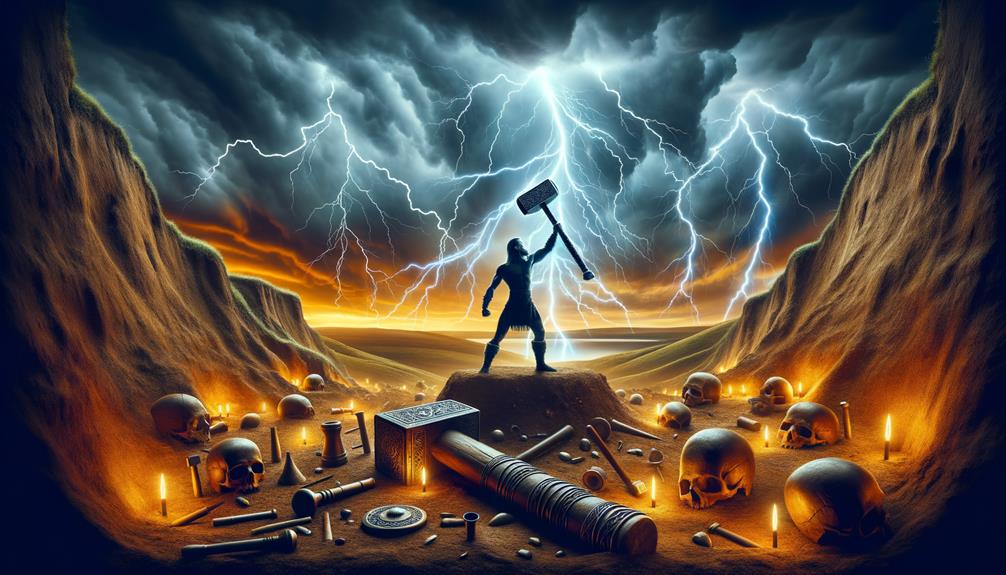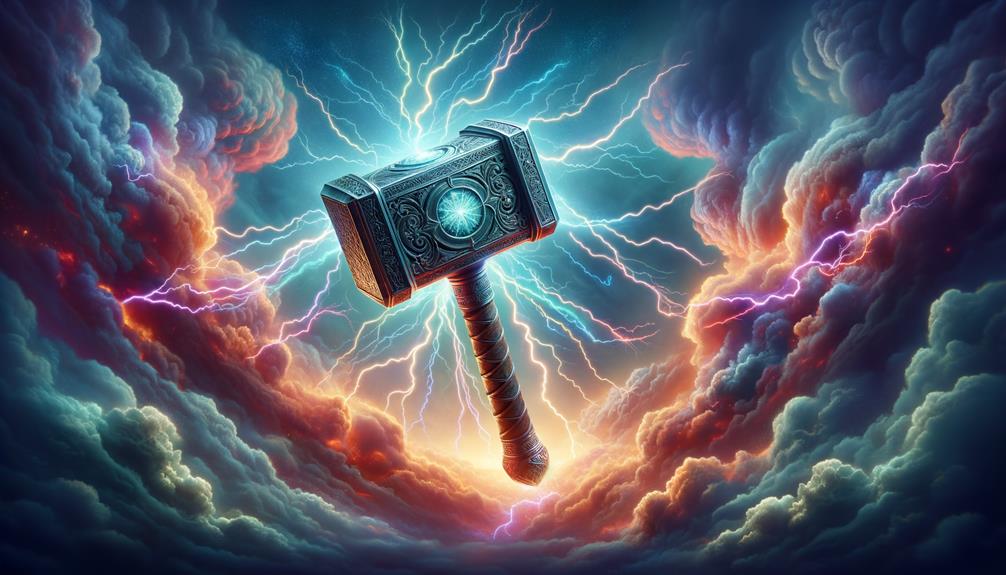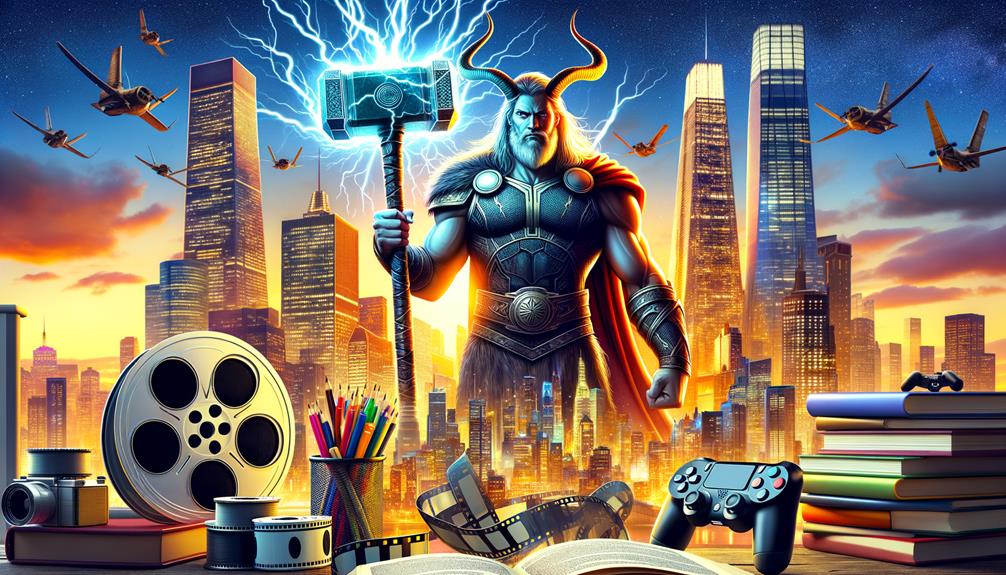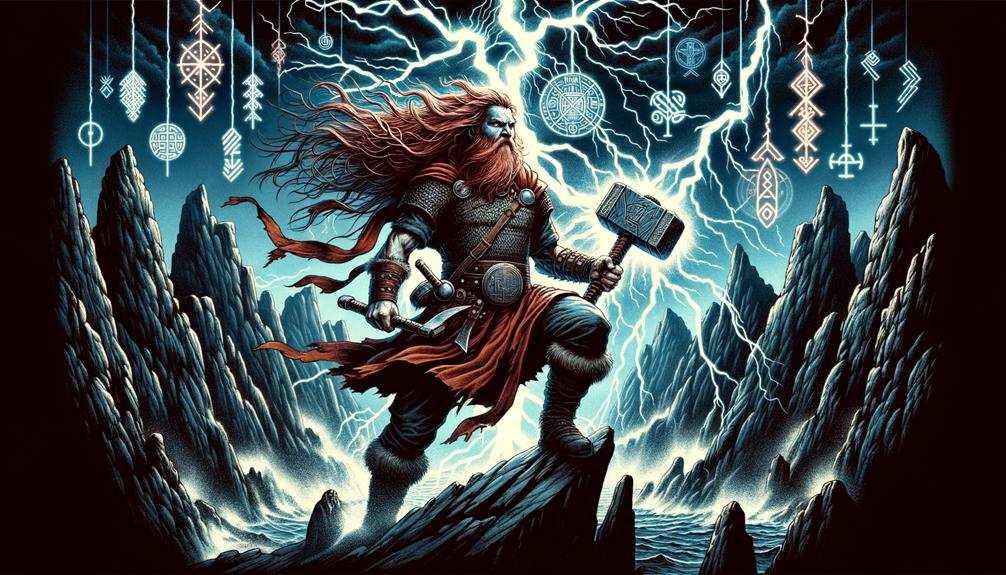Thor: The Titanic Thunder God of Norse Mythology
Thor, the Norse god of thunder, is a towering figure symbolizing unassailable power and fortitude. As I've delved into the ancient Germanic lore during my academic journey, I have encountered countless testaments to Thor's power. Each narrative, rich with his heroic exploits, battles against colossal creatures, and his iconic Mjölnir – a hammer capable of summoning storms and lightning, bears witness to his unmatched supremacy.
However, the intriguing question remains: What profound symbolism do these stories carry? And how does Thor's omnipotent persona continue shaping our contemporary culture? The answers may astonish you. Hence, let's embark on an exploration to uncover the thunderous might of Thor, the Norse god of storms.
The Unyielding Strength of Thor: A Closer Look at His Heroic Deeds
Every tale of Thor's heroism, from his battles against menacing giants to the defense of the cosmos, reinforces his image as an unstoppable force. His weapon, Mjölnir, is not merely a hammer. It's a symbol of his dominion over storms and lightning, further cementing his status as a powerful deity.
However, these narratives are not just thrilling stories. They are metaphors, teeming with deeper meanings. For instance, Thor's continuous battle against giants could represent the human struggle against insurmountable odds. His iconic hammer, Mjölnir, could symbolize the power of nature and its raw, uncontrolled energy.
Thor's Influence on Modern Culture: A Thunderous Impact
Thor's omnipotent image doesn't just reside in ancient texts. It continues to shape our modern cultural landscape. From the Marvel Cinematic Universe's portrayal of the thunder god to the use of his name in popular music and literature, Thor's influence is undeniable.
Even in our daily lives, we can see bits and pieces of Thor's legacy. For example, Thursday, or 'Thor's Day,' is a weekly reminder of the thunder god's enduring influence.
Unraveling the Thunderous Might of Thor
So, join me as we delve deeper into the thunderous might of Thor. Together, we'll uncover the symbolism behind his tales, explore his influence on modern culture, and perhaps even discover some unexpected truths along the way.
In the end, the journey through Thor's lore is not just about understanding an ancient deity. It's about acknowledging the enduring power of mythology and its influence on our lives. The thunderous might of Thor, the Norse god of storms, continues to echo through the ages, reminding us of the indomitable strength within us all.
Thor's Historical Attestations

The Thunderous Majesty of Thor in Germanic Paganism
In the realm of Germanic paganism, Thor consistently stands out as a key figure, revered for his powerful symbolism and association with thunder, lightning, and storms. His connection with the sacred groves and trees further extends his divine reach. As a deity of thunder, Thor's historical records are abundant, highlighting his pivotal position in the Norse gods' pantheon.
Thor and Mjöllnir: The Inseparable Duo
Born from Odin, Thor's wielding of the majestic hammer, Mjöllnir, is a testament to his potent authority. This hammer, a significant emblem of Thor's power, coupled with his control over storms, and his defense of Asgard and Midgard, underscores the critical balance he maintains across realms.
Thor's Battles and Guardianship: The Protector of Realms
The mythological tales of Thor's skirmishes against giants echo through time, accentuating his role as the protector of both gods and humans. His tie to sacred groves and trees portrays him as a guardian, reinforced by his robust strength and fertility.
Beyond Norse Mythology: Thor's Cultural Impact
Moving beyond the boundaries of Norse mythology, Thor's worship permeated the broader cultural sphere. Early Germanic communities held him in high esteem, and his influence continues to ripple through modern pop culture. This continuous fascination with Thor, from historical evidence to contemporary interpretations, attests to the thunder god's immense power and relevance.
The Timeless Appeal of Thor
"Thor's enduring appeal, from historical attestations to present-day interpretations, attests to the thunder god's might and significance."
His timeless appeal resonates in various forms of media, from comics to blockbuster movies. His varied portrayals in pop culture, like Marvel's Thor, testify to his continuing relevance. It's this enduring fascination that makes Thor an intriguing god to explore, whether you're a history buff, mythological enthusiast, or pop culture fan.
*Thor's journey, from the annals of Germanic paganism to the pop culture icon he is today, is a testament to his enduring appeal and the fascinating tales woven around him.*
Archaeological Records Related to Thor

Contextualizing Thor's Legacy Through Archaeological Records
Thor's influences, both cultural and mythological, are unmistakable. However, the abundant archaeological records related to Thor, spanning artifacts to inscriptions, truly shed light on his widespread worship during the Viking Age. The Old Norse texts, the Prose Edda and Poetic Edda, imply that Thor and Odin were held in high esteem. Yet, it's through tangible evidence, like amulets and runestones, we can truly perceive Thor's profound influence.
Thor's Hammer Mjölnir: More Than Just a Weapon
Thor's symbolic weapon, Mjölnir, is a frequent presence in these archaeological finds, often symbolizing protection. This corroborates Thor's depiction as a divine guardian in the Eddas. Mjölnir-emblazoned personal items hint at Thor's intimate role in people's everyday lives. Meanwhile, its existence in sacred places, such as the Temple at Uppsala, emphasizes Thor's importance in public worship rituals.
Geographical Reach of Thor-Related Findings
The wide geographic distribution of Thor-related discoveries underlines his lasting cultural and religious influence across varied regions. Whether it's a Mjölnir pendant from Scandinavia or a stone inscribed with Thor's name from the British Isles, the implication is evident: Thor transcended beyond mere mythology, becoming an integral part of Viking Age society.
In sum, Thor was not just a legendary figure; he played a pivotal role in their society. The archaeological findings serve as a testament to this fact, allowing us to comprehend Thor's significant influence. A thorough exploration of these artifacts and inscriptions can provide a richer understanding of not just Thor, but also of the Viking Age as a whole.
As we delve deeper into these archaeological records, we unravel the threads of history, and Thor's legacy comes to life, as real and tangible as the artifacts that bear his mark.
Origin and Interpretations of Thor

Understanding the Mighty Thor: Origins and Interpretations
Dive into the fascinating world of Thor, represented as an emblematic persona within the realm of Germanic paganism. Thor is lauded for his connections to elemental forces such as lightning, thunder, and storms, in addition to sacred groves and trees. Revered as a potent symbol of strength and power, he stands as a guardian not only to the gods but also to mankind. The mighty hammer of Thor, known as Mjölnir, is a testament to his authority, bestowing upon him the power to command natural elements, especially lightning and thunder.
Venturing deeper into the persona of this Norse deity, Thor's warrior spirit comes to the fore. He is frequently portrayed engaging in fierce battles with giants, exemplifying courage and honor. His gallant image cements his status as a figure of valor among the Germanic pantheon, standing on par with deities like Odin and Loki.
One intriguing aspect of Thor's character is his link to fertility, highlighted by his association with sacred groves and trees. Devotees often sought his blessings and protection, which further elevated his stature. Thor's name continues to command awe and respect, extending its influence from the realm of mythology to the sphere of contemporary culture. His symbol, the hammer Mjölnir, served as a protective talisman during the Viking Age and continues to be a widely recognized icon today.
The Symbolism of Thor's Hammer

Let's delve into the mystique of Mjölnir, the formidable hammer wielded by Thor. This potent symbol, deeply rooted in mythology, carries a powerful aura of dominance and might, much akin to its divine owner, Thor. Far from being a mere weapon, this hammer serves as an emblem of celestial authority, warding off the disorderly forces epitomized by characters such as Loki.
- Mjölnir and the Thunder Connection: Drawing from Old Norse linguistics, 'Thor' translates to thunder, thereby establishing a clear connection between Thor's hammer and thunderous might. This association perfectly aligns with Thor's persona as a storm deity, drawing parallels with the Roman god, Jupiter.
- The Thor-Loki Dichotomy: Loki stands as an embodiment of trickery and turmoil, while Thor, wielding his hammer, symbolizes order and righteousness. This stark contrast underscores the pivotal role of Thor's hammer in preserving equilibrium.
- Mjölnir's Multifaceted Functionality: Mjölnir transcends its symbolic significance, boasting practical relevance as well. It is believed to have been used in rituals blessing weddings, welcoming newborns, and memorializing the deceased, attesting to its crucial part in the everyday life of the Norse people.
Let's draw the curtains on our exploration of Mjölnir's symbolism. This awe-inspiring icon of Thor's strength not only inspires fascination but also stands as a testament to Thor's pivotal role in maintaining cosmic harmony against the chaotic forces personified by Loki. Remember, every symbol has a story to tell, and Mjölnir's tale is one of power, balance, and divine authority.
Thor's Influence in Popular Culture

Thor's Impact in the Realm of Popular Culture: A Timeless Tale
Numerous references from Thor's lore permeate various forms of entertainment, underlining his enduring impact on popular culture. Thor's appeal skyrocketed with his debut in the Marvel Cinematic Universe, where narratives featuring the thunder deity emerge consistently, each deepening his imprint on the public's mind. Equipped with his emblematic hammer, Mjölnir, Thor carries a heritage that has soared beyond temporal and spatial boundaries.
The Germanic tribes embraced Thor's mythology, engraving his symbols on their arms and treasures. The echoes of these cultural practices reverberate today, emphasizing Thor's lasting influence. Moreover, Thor's links to thunder and lightning, his might, and his dauntlessness have been adopted and reimagined across various media platforms, thus magnifying his footprint in our shared consciousness.
Thor's Adventures: A Glimpse into Norse Mythology
A Norse myth tells a fascinating tale of Thor disguised as a bride to reclaim his stolen hammer. This narrative presents Thor's wife, the goddess Sif, and underscores Thor's wit and his profound bond with his weapon. Such stories, and many more, contribute to the robust and enduring influence that Thor wields in popular culture.
The Thunder God's Legacy
With each Marvel Cinematic Universe installment featuring Thor, his popularity soars. His presence, as strong as his hammer Mjölnir, leaves an indelible mark on our collective psyche. From ancient Germanic tribes to modern-day comic book fans, Thor's mythology continues to resonate, proving that his influence is as timeless as the thunder god himself.
Frequently Asked Questions
Who Is the God of Thunder and Might?
Discover the Mighty Norse God of Thunder
In the fascinating realm of Norse mythology, the identity of the thunder and might deity isn't explicitly mentioned. Yet, this compelling god is renowned for his audacious battles, his command over a formidable hammer, and his intimate connection with storms. These attributes paint a vivid picture of a figure representing both strength and courage.
Wielding Power: The God's Weapon of Choice
An intriguing facet of this mighty god's character is his choice of weapon. He brandishes a hammer of immense power, an emblem of his strength and valor. This tool is not just a symbol, but also a practical asset in his fierce battles, demonstrating the god's strategic genius and martial prowess.
A Thunderous Link: The God and Storms
Storms, with their thunderous roars and electrifying displays, are a significant symbol associated with this god. They not only reflect his turbulent and powerful personality but also reinforce his dominion over thunder and might. This association offers a real-world connection, helping us understand the god's formidable stature in Norse mythology.
Strength and Bravery: Core Attributes of the Thunder God
The Norse god of thunder and might is an embodiment of strength and courage. His legendary battles showcase his bravery, while his powerful hammer and association with storms underscore his strength. These attributes make him a compelling figure in Norse mythology, resonating with those seeking strength and courage in their own lives.
Experience Norse Mythology: Dive Deeper into the World of Gods
To learn more about the Norse god of thunder and might, consider exploring a curated selection of books and documentaries about Norse mythology. These resources will give you a deeper understanding of this deity's role and significance, and they further illuminate the rich tapestry of Norse myths.
Who Is the Norse God of Thunder?
Unmasking the Mighty Thor: The Norse God of Thunder
In the captivating realm of Norse mythology, the god synonymous with thunder and tempests is none other than the valorous Thor. Famed for his formidable strength and unmatched bravery, Thor is traditionally portrayed brandishing Mjölnir, a potent hammer embodying his sovereignty and might.
Thor's Strength and Bravery: A Beacon in the Storm
Engaging with Norse mythology, you'll quickly discover Thor's reputation as a warrior. His courage is legendary, facing fearsome foes and weathering raging storms, all with unyielding strength and bravery. This makes Thor an indispensable figure in Norse mythology, as well as a real-world example of a classic hero archetype.
Mjölnir: The Hammer of Authority
The tool that amplifies Thor's authority, Mjölnir, is no ordinary hammer. It's a masterful symbol of power and control, revealing Thor's status as the god of thunder. Mjölnir is a unique artifact in the Norse pantheon, much like the trident is to Poseidon in Greek mythology.
The Impact of Thor in Modern Culture
Thor's influence doesn't end with ancient mythology. He's a central character in modern pop culture, dominating comic books, movies, and merchandise. For those curious about Thor's mythological background, we recommend the book "Norse Mythology" by Neil Gaiman. It provides a comprehensive and engaging exploration of the Norse pantheon, including Thor and his mighty hammer, Mjölnir.
What Did the Norse Believe Thunder Was?
The Norse Interpretation of Thunder – A Divine Chariot or Hammer in the Sky
The Norse, in their intriguing mythology, perceived thunder in quite a unique way. Have you ever wondered what that might be? Well, their belief was that the thunderous sounds echoing during a storm were nothing less than the reverberations of a divine entity in action.
Imagine this – a god steering his chariot across the vast expanse of the sky or wielding his formidable hammer with such might that it generates thunder. A fascinating perspective, isn't it? This was seen not just as a random occurrence, but as a potent symbol of divine power and protection.
We should remember that this belief, like any other, gave meaning and context to the world around them. It also provided a sense of security and comfort in the face of nature's raw power. So next time when thunder rolls, think about the Norse interpretation. It might even give you a different perspective!
Remember, the Norse mythology is rich, complex, and highly engaging, just like the thunder belief we've explored today. I encourage you to delve deeper into this intriguing world. Who knows, you might find more fascinating beliefs that will make you appreciate the complexity and richness of human imagination.
In the Clamor of the Storm, the Norse Heard the Echo of Divine Power
In conclusion, the Norse mythology, with its unique interpretation of natural phenomena like thunder, offers us a glimpse into the minds of our ancestors. Their beliefs, while different from ours, present a compelling worldview that can still inspire awe and wonder today.
Can Thor Summon Lightning in Norse Mythology?
Understanding Thor's Powers in Norse Mythology: A Glimpse at His Ability to Summon Lightning
Indeed, Norse mythology paints a vivid picture of Thor, the god of thunder, endowed with the electrifying ability to summon lightning. This fascinating trait is not just a subtle characteristic, but an integral part of his persona that comes to the fore during his epic showdowns with giants.
Thor's Lightning: A Symbol of Power and Fearlessness
Harnessing the raw energy of nature, Thor's power to summon lightning reflects his indomitable spirit and fearlessness. This unique ability places him among the most formidable gods in Norse mythology, often leaving his adversaries in awe. His battles against the giants, fortified by his control over lightning, serve as a testament to his immense power and the crucial role he plays in maintaining harmony in the cosmos.
Thor's Power in Action: A Real-World Example
Imagine a thunderstorm; the sky roars, and a flash of lightning illuminates the darkened clouds. This is Thor in action, according to Norse mythology. His power over lightning is not just for show; it's a weapon he uses strategically in his battles, striking fear into the hearts of giants and protecting the realms from chaos.
Final Thoughts
In conclusion, Thor's ability to summon lightning, as depicted in Norse mythology, is a compelling aspect of his character that defines his role and influence within the mythological narrative. It showcases his unyielding strength and the pivotal part he plays in the balance of power. Through the lens of Norse mythology, we witness the god of thunder harnessing the elements, shedding light on the awe-inspiring world of ancient beliefs and legends.

